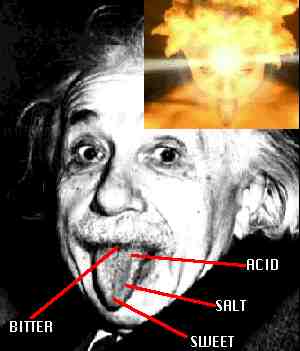About Taste
Enjoying a fine glass of wine involves all the senses: the sounds of clinking glass or bubbling champagne, the feel of the wine in your mouth, the color, the bouquet... Still, no one would deny that one of the key aspects of enjoying wine is the taste. After all, it's the sense that puts the "taste" in "winetasting!"
But how does it work?
It's All In The Tongue... Or Is It?
The human tongue has four basic classes of taste receptors: sweet, salt, acid and bitter. In truth, all four tastes can be perceived anywhere on the tongue, or even on the roof of the mouth. But certain zones have receptors that are more sensitive to particular attributes:
- Sweet (sugars) [on the tip of the tongue]
- Saltiness (salts) [flanking the sweet zone]
- Acid (sour): low pH, acidic foods like lemon juice or vinegar [along the sides of the tongue]
- Bitter (bases): high pH, alkaline foods like baking soda or unsweetened chocolate [far back on the tongue]

When you taste wine, swirl it around in your mouth a bit. Sip in enough to cover your tongue. You want to get the maximum effect, and make sure all parts of your mouth get to experience the wine.
If there are only four taste zones, you may well ask, where does all the complexity come from? How can we possibly perceive raspberries, oak, black pepper or coffee grounds in a wine? Well, taste is actually linked closely to smell. Much of what we taste is strongly influenced by our olfactory receptors. Some of the smells get in through your nose. Others make their way in through the retronasal passage at the back of the mouth. This is the other reason for swirling the wine around in your mouth, or even "chewing" the wine -- the action helps release chemical compounds and allow them to reach the olfactory membrane. Humans can recognize literally thousands of distinct odors.
See also Wines International's Guide to your Palate and Michael Berry's The Physiology of Taste.
The Fundamental Taste Components of Wine
The four major components of wine tastes are sweetness, tannins, acidity and alcohol. The tannins and acid give the wine a hard edge, while the sweetness and alcohol help soften those edges. A "balanced" wine is one in which the components are well matched. If one of these components overwhelms the others, the wine is said to be "unbalanced": cloyingly sweet, perhaps, or too tart.
- Sweetness. Some wines are "dry", that is, they aren't sweet -- most the sugars have been turned to alcohol during fermentation. Other wines may have some residual sugar, or they may have been sweetened. Thus wines may vary from dry, off-dry, semi-sweet, to sweet.
- Tannins. Tannins are a substance that occurs naturally in grapes, most notably in the skins and seeds. (Regular tea is another substance that contains tannins). Because red wines are kept in contact with the grapeskins during fermentation, they are generally more tannic than white wines. Thus, tannins are often a major component in reds. In highly tannic wines (for example, young cabernet sauvignons) the tannins may seem a bit overpowering, especially to the novice wine drinker. Have you encountered that thick component to a red wine that leaves your mouth dry? That is probably tannins. Proper aging of the wine can smooth out the tannins and let some of the other flavors come out -- one of the main reasons certain red wines are better when aged.
- Acidity. Wines contain acid (notably tartaric acid from the grapes); thus they are low pH. Acidity is what gives wines a "crisp" character, and it can be felt on the sides of the tongue. Wines with insufficient acidity may seem flat or flabby. The acidity is particularly important in white wines, which have less tannins than reds, and thus the acidity provides much of the "backbone" to the wine. Like tannins, acid can also feel dry in the mouth, but unlike tannins they produce a salivation response.
- Alcohol. Alcohol is the fourth major component of the wine taste. It can soften the "edge" to the wines that acidity and tannins give, or make the wine seem thicker, more full-bodied. But overpowering alcohol can leave the mouth with a burning sensation.
Final Note: Apples and Cheese
If the wine is too tannic, serve it with a little soft cheese. Dairy products can bind to the tannins and help soften them in the mouth. Apples, on the other hand, are rumored to enhance defects in the wine. "Buy on apples; sell on cheese" is an old vintner's saying. It is their equivalent to the sailor's "red sky at night, sailor's delight; red sky at morning, small craft advisory in effect until noon." (Or however it goes).
Other "Tasteful" Sites of Interest
Return to Main Page

